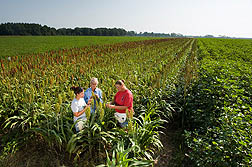USA
July 18, 2016

Entomologist Patricia Glynn Tillman (center), technician Kristie Graham (right), and student technician Brittany Giles evaluate a sorghum trap crop being used to control stink bugs in adjacent fields of peanuts and cotton. - Photo by Stephen Ausmus.
A U.S. Department of Agriculture (USDA) entomologist has found "green" alternatives to insecticides to control three native stink bugs that damage cotton, and the new methods are catching on with growers.
The green stink bug (Chinavia hilaris), southern green stink bug (Nezara viridula), and brown stink bug (Euschistus servus) are a particular problem in the southeastern United States, because cotton is often grown alongside peanuts. Brown and southern green stink bugs develop in peanut fields and migrate into cotton. Green stink bugs move into cotton from nearby wooded areas.
Glynn Tillman, with USDA's Agricultural Research Service (ARS) in Tifton, Georgia, is studying the use of "trap crops," such as soybean and grain sorghum. Trap crops are planted in small strips alongside cotton so that the stink bugs will move into them instead.
Another option is using pheromone-baited traps to capture and kill the bugs. Nectar-producing plants can be grown to attract native parasitoid wasps that attack stink bugs. Placing plastic barriers between cotton and peanut rows is yet another control method.
In a recent study, Tillman and her colleagues grew cotton and peanuts side by side for two years. In the first year, they planted soybeans as a trap crop, with and without pheromone traps, between the cotton and peanut rows. In other areas, they placed 6-foot-high plastic barriers between the rows. In the second year of the study, they added nectar-producing buckwheat plants near the cotton. Each week during the May-to-October growing season, they counted the stink bugs and stink bug eggs killed by wasps, and documented the damage to cotton bolls.
They found that physical barriers between peanut and cotton were the most effective tool and that the multi-pronged approach is an effective alternative if barriers are not feasible. They also found that soybeans were an effective trap crop and that buckwheat plants attracted beneficial wasps that reduced stink bug numbers.
Read more about this research in the July 2016 issue of AgResearch.
ARS is USDA's principal intramural scientific research agency.